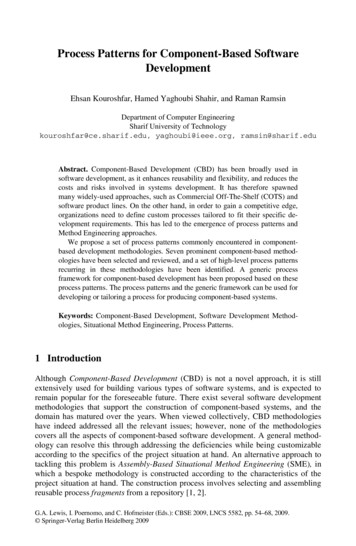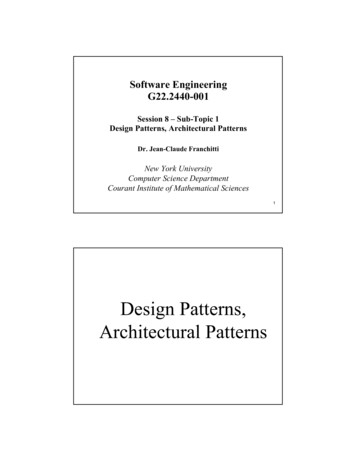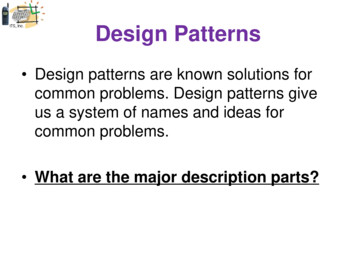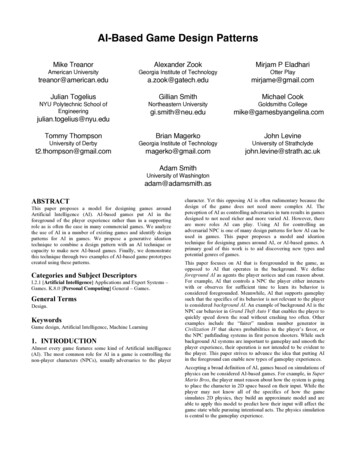
Transcription
Process Patterns for Component-Based SoftwareDevelopmentEhsan Kouroshfar, Hamed Yaghoubi Shahir, and Raman RamsinDepartment of Computer EngineeringSharif University of Technologykouroshfar@ce.sharif.edu, yaghoubi@ieee.org, ramsin@sharif.eduAbstract. Component-Based Development (CBD) has been broadly used insoftware development, as it enhances reusability and flexibility, and reduces thecosts and risks involved in systems development. It has therefore spawnedmany widely-used approaches, such as Commercial Off-The-Shelf (COTS) andsoftware product lines. On the other hand, in order to gain a competitive edge,organizations need to define custom processes tailored to fit their specific development requirements. This has led to the emergence of process patterns andMethod Engineering approaches.We propose a set of process patterns commonly encountered in componentbased development methodologies. Seven prominent component-based methodologies have been selected and reviewed, and a set of high-level process patternsrecurring in these methodologies have been identified. A generic processframework for component-based development has been proposed based on theseprocess patterns. The process patterns and the generic framework can be used fordeveloping or tailoring a process for producing component-based systems.Keywords: Component-Based Development, Software Development Methodologies, Situational Method Engineering, Process Patterns.1 IntroductionAlthough Component-Based Development (CBD) is not a novel approach, it is stillextensively used for building various types of software systems, and is expected toremain popular for the foreseeable future. There exist several software developmentmethodologies that support the construction of component-based systems, and thedomain has matured over the years. When viewed collectively, CBD methodologieshave indeed addressed all the relevant issues; however, none of the methodologiescovers all the aspects of component-based software development. A general methodology can resolve this through addressing the deficiencies while being customizableaccording to the specifics of the project situation at hand. An alternative approach totackling this problem is Assembly-Based Situational Method Engineering (SME), inwhich a bespoke methodology is constructed according to the characteristics of theproject situation at hand. The construction process involves selecting and assemblingreusable process fragments from a repository [1, 2].G.A. Lewis, I. Poernomo, and C. Hofmeister (Eds.): CBSE 2009, LNCS 5582, pp. 54–68, 2009. Springer-Verlag Berlin Heidelberg 2009
Process Patterns for Component-Based Software Development55Process patterns were first defined as “the patterns of activity within an organization (and hence within its project)” [3]. Later definitions focused on defining patternsas practical process chunks recurring in relevant development methodologies. Onesuch definition, focusing on the object-oriented paradigm, defines a process pattern as“a collection of general techniques, actions, and/or tasks (activities) for developingobject-oriented software” [4]. Process patterns are typically defined at three levels ofgranularity: Tasks, Stages and Phases [4]. A Task process pattern depicts the detailedsteps to perform a specific task. A Stage process pattern includes a number of Taskprocess patterns and depicts the steps of a single project stage. These steps are oftenperformed iteratively. Finally, a Phase process pattern represents the interactionsbetween its constituent Stage process patterns in a single project phase. Phase process patterns are typically performed in a serial manner.Since process patterns describe a process fragment commonly encountered in software development methodologies, they are suitable for being used as process components. They can thus be applied as reusable building blocks in an assembly-basedSME context, providing a repository of process fragments for assembling processesthat are tailored to fit specific projects or organizational needs. The OPEN ProcessFramework (OPF) is an example of using process patterns for general method engineering purposes [5]. Sets of process patterns can also be defined for specific development approaches; the object-oriented process patterns of [4], and the agile processpatterns proposed in [6] are examples of domain-specific patterns, and have indeedinspired this research.Although a number of process patterns have been introduced in the context ofcomponent-based development [7], a comprehensive set of patterns providing fullcoverage of all aspects of component-based development has not been previouslyproposed. We propose a set of process patterns commonly encountered in componentbased development. The patterns have been identified through studying sevenprominent component-based methodologies. A generic process framework, the Component-Based Software Development Process (CBSDP), has been constructed basedon these process patterns. The generic framework and its constituent process patternscan be used for developing or tailoring a methodology for producing componentbased systems. It should be noted that the proposed framework is not a new methodology for component-based development, but rather a generic pattern-based SMEmodel for CBD: method engineers can instantiate the generic framework and populateit with instances of the constituent process patterns according to the particulars oftheir CBD projects. This approach is already prevalent in methodology engineeringframeworks such as OPEN/OPF [8], SPEM-2 [9], and the Eclipse Process Framework(EPF) [10]; indeed, the proposed framework and process patterns can be defined andused as method plug-ins in the Eclipse Process Framework Composer (EPFC) tool.The rest of the paper is structured as follows: Section 2 provides brief descriptionsof the seven CBD methodologies used as pattern sources; Section 3 contains the proposed generic framework for component-based software development (CBSDP); inSection 4, the proposed phase-, stage-, and task process patterns are explained;Section 5 validates the patterns through demonstrating how the proposed patternscorrespond to the methodologies studied; Section 6 contains the conclusions and suggestions for furthering this research.
56E. Kouroshfar, H. Yaghoubi Shahir, and R. Ramsin2 Pattern Sources: Component-Based Software DevelopmentMethodologiesThe seven methodologies that have been studied for extracting process patterns are:UML Components, Select Perspective, FORM, KobrA, Catalysis, ASD, and RUP.These methodologies were selected because they are well-established and mature, andalso because adequate resources and documentation are available on their processes.We briefly introduce each of these methodologies in this section.UML Components is a UML-based methodology aiming to help developers usetechnologies such as COM and JavaBeans for defining and specifying components[11]. The process shows how UML can be used in a CBD context; that is, to definecomponents, their relations, and their use in the target software system.Select Perspective was the result of combining the object modeling language introduced in [12] with the Objectory use-case-driven process (later integrated into RUP).In its original form, it incorporated business modeling, use case modeling and classmodeling activities. A CBD extension was later added, addressing business-orientedcomponent modeling, component modeling of legacy systems, and deployment modeling. Select is based on a service-oriented architecture adapted from the MicrosoftSolution Framework application model. It constitutes of three types of services: userservices, business service, and data services.Feature-Oriented Domain Analysis (FODA) was introduced in 1990, and presentedthe idea of using features in requirement engineering [13]. It was later extensivelyused in several product-line engineering methods. One such method is the FeatureOriented Reuse Method (FORM) [14, 15], which has added the features of architectural design and construction of object-oriented components to FODA, thus providinga CBD methodology.The KobrA methodology is based on a number of advanced software engineeringtechnologies, including product-line engineering, frameworks, architecture-centricdevelopment, quality modeling, and process modeling [16, 17]. These methods havebeen integrated into KobrA with the specific aim of systematic development of highquality, component-based software systems.The Catalysis methodology is a component-based approach based on objectoriented analysis and design [18]. It has been influenced by other object-orientedmethodologies such as Syntropy and Fusion. Catalysis provides a framework forconstructing component-based software.The Adaptive Software Development (ASD) methodology was introduced in1997 [18], and is the only Agile method that specifically targets component-baseddevelopment.The Rational Unified Process (RUP) is the most well known of the selectedmethodologies [18]. As a third-generation object-oriented methodology, RUP is usecase-driven and architecture-centric, and incorporates specific guidelines for component-based development. It should be noted, however, that RUP has evolved into amethod engineering framework (Rational Method Composer – RMC); a further testimony to the changing nature of software engineering, stressing the importance ofprocess patterns in this new trend.
Process Patterns for Component-Based Software Development573 Proposed Component-Based Software Development Process(CBSDP)A thorough examination was conducted on the selected methodologies, as a result ofwhich, 4 phase process patterns, 13 stage process patterns, and 59 task process patterns were identified.The process patterns have been organized into a generic process framework forCBD methodologies. This framework, which we have chosen to call the ComponentBased Software Development Process (CBSDP), is shown in Figure 1. CBSDPconsists of four phases (each considered a phase process pattern): Analysis, Design,Provision, and Release.AnalysisRequirementsOutline planComponentbased ngineeringComponentTestReleaseTest in thelargeAssemblyDeployCBDLegendFig. 1. The proposed Component-Based Software Development Process (CBSDP)The process begins with the Analysis phase, in which the requirements of thesystem are elicited first. The applicability of the component-based approach to theproject at hand is then investigated; after all, the component-based approach may notbe suitable for the project. The infrastructure of the project is then defined, and apreliminary project plan and schedule is outlined. In the Design phase, the components of the system are identified; based on the interactions among these components,complete specifications are defined for each component. In the Provision phase,components are classified into two categories: Those which are retrieved from a repository of reusable components, and those which are constructed from scratch. Components are then developed and tested individually. In the Release phase, componentsare assembled together to form the system proper. After system testing is conducted,the end-product will be deployed into the user environment.It is worth noting that CBSDP is a framework that guides the method engineerwhen assembling instances of process patterns. Not all stage process patterns inCBSDP are mandatory; pattern selection is based on the needs of the project situationat hand. For example, suppose that a method engineer needs to construct a methodology for a product line project that is similar to a previous project. Hence, the Component-based Justify stage will not be required in the Analysis phase. In addition, theConcurrent Engineering stage in the Provision phase could be omitted, since it maybe possible to use existing components instead of constructing new ones.
58E. Kouroshfar, H. Yaghoubi Shahir, and R. Ramsin4 Proposed Stage and Task Process PatternsIn this section, details of the Stage process patterns constituting each of the fouraforementioned phases are discussed. Furthermore, some of the constituent Taskprocess patterns are briefly reviewed in the descriptions. As previously mentioned,these process patterns can be used independently by method engineers to extend/enhance an existing process, or to construct a new component-based softwaredevelopment methodology.It is important to note that the arrows connecting the task process patterns do notimply any sequencing. Although it is logical to assume that some of the tasks willprecede others, we do not intend to impose any such ordering. The main purpose ofthis approach is to enable the method engineer to decide the order of the tasks basedon the specifics of the project situation at hand.4.1 RequirementsRequirements Engineering is where the high level Requirements of the target systemare defined (Figure 2). The inputs to this stage include the Project Vision and theCustomer’s Viewpoints on the different aspects of the project. The key factor in component-based development projects – as emphasized in many component-based methodologies such as Select Perspective, UML Components, and KobrA – is how to useprevious experience and existing components in future projects. In order to supportthis purpose, Existing Components and Previous Projects’ Assets are two importantinputs to this stage.LegendTaskProject Description,Project Vision,Existing Components,Previous Projects,Customer’s ementsDocument,ModelsFig. 2. Constituents of the Requirements stage process patternRequirements are defined during the Problem Domain Analysis task. During Interaction Analysis, the interactions of the system with its environment are examined. Thesystem boundary and the external actors interacting with the system are thus determined. In the Responsibility Analysis task, the main functionalities of the system areinvestigated, and functional and non-functional requirements are identified throughactive collaboration with the customer. The customer’s approval is obtained throughthe Get Customer’s Approval task.
Process Patterns for Component-Based Software Development594.2 Define InfrastructureThe Project Infrastructure should be defined at the beginning of the project. Asshown in Figure 3, it includes Standards, Teams Definition, Tools used during theproject, and the Development Platform. The tailored version of the development process to be used in the project is also determined, with Method Constraints (coveringmodeling, testing, build, and release activities) duly defined. In product-line engineering and component-based projects, the Project Infrastructure is a key product becauseit can be used in various projects. Similarly, the infrastructure of previous projects canbe tailored for use in future projects.The inputs to this stage are the requirements extracted in the Requirements stage,along with previous experiences compiled in the Previous Projects document, Existing Infrastructure, and the Project Plan. As a result, the Project Infrastructure Document and Team Definition are produced. The requirements document may be refinedduring this stage.In cases where the organization imposes predefined standards and developmentplatforms, the Select Standards and Specify Development Platforms tasks are notapplicable. These tasks have therefore been defined as optional.Define TeamsLegendTaskRequirements,Previous Projects,Existing Infrastructure,Project PlanSelectStandardsOptionalSelect . 3. Constituents of the Define-Infrastructure stage process pattern4.3 Outline PlanIn this stage of the CBSDP (Figure 4), the initial project management documents(such as project scope, time schedule, etc.) are produced. The management documentsare used and updated during the development lifecycle.The inputs to this stage are the Requirements Document, Infrastructure Document,Existing Components, and Project Objectives. Preliminary estimation of time andresources and the definition of the project scope are also performed during this stage.An initial viable schedule is then outlined for the project. Based on the team definitionprovided in the infrastructure document, the work units are assigned to team members. Initial risk assessment activities are also conducted in this stage.In component-based projects, there is a need to study the market in order to obtaininformation about existing systems, similar solutions, and reusable components. Thisinformation can be used in time and resource estimation, and also when preparing aninitial schedule for the project.
60E. Kouroshfar, H. Yaghoubi Shahir, and R. RamsinThe Project Plan, Management Document and Risk Assessment are the deliverables of this stage. The management document contains all the information needed formanaging the project. It includes the project plan and schedule (among other things),and may be refined during later stages of the project.LegendRequirementsDocument,Infrastructure Document,Existing Components,Project ObjectivesTaskTime andResourceEstimationDefineProject ScopeInitial RiskAssessmentCreate InitialScheduleProject Plan,ManagementDocument,Risk AssessmentFig. 4. Constituents of the Outline-Plan stage process pattern4.4 Component-Based JustifyThis stage determines whether the component-based approach can be used on theproject at hand (Figure 5). It is a critical stage of the analysis phase since it checks ifthe project makes sense in a component-based context. It makes use of the Requirements Document, Risk Assessment Document, Existing Components and PreviousProjects experience to produce the Feasibility Study and the Business Case, whichjustifies the project financially.LegendStageTaskCBDRequirements Document,Risk Assessment ,Existing Components,Previous ty Study ,Business CaseFinancialAnalysisTechnicalAnalysisFig. 5. Constituents of the Component-based-Justify stage process patternDuring the Technical Analysis task, we investigate whether it is possible to buildthe system and realize all of its functional features on the basis of components. SinceReusability Analysis contains various tasks, it is defined as a stage process pattern. Inthis stage, the component repository is first checked in order to assess the applicability of existing components; furthermore, the system components which are to be produced during the current project are explored as to their potential reusability. Duringthe Market Analysis task, we search for similar components and systems available onthe market. We also investigate the marketability of the components developed for thenew system. Based on this information, Financial Analysis is performed to assess theeconomic feasibility of the project.
Process Patterns for Component-Based Software Development614.5 Component IdentificationThe second phase, Design, starts with the Component Identification stage (Figure 6).It accepts the Requirements Document, Existing Interfaces, Existing Components,Previous Projects, and the Business Case as input. The main goal of this stage is tocreate an initial set of interfaces and component specifications. It determines theSystem Interfaces from the interactions between the system and its environment.Business Interfaces and Technical Interfaces are also identified in this stage. BusinessInterfaces are abstractions of all the information that should be managed by the system, while Technical Interfaces manage the technical components (such as databasecomponents). The Business Type Model contains the specific business informationthat must be maintained by the system, and will be used in the Component Specification stage. Furthermore, an Initial Architecture and Components Specification aredefined in this stage. At the end of this stage, the Business Type Model, System Interfaces, Business Interfaces, and Component Specs and Architecture will be isting Interfaces,Existing Components,Previous Projects,Business CaseDevelopBusiness alInterfacesIdentifySystemInterfacesDefine InitialArchitectureCBDDefine InitialComponentSpecificationBusiness TypeModel,System Interfaces,Business Interfaces,Component Specsand ArchitectureFig. 6. Constituents of the Component-Identification stage process pattern4.6 Component InteractionAfter defining an initial set of components and their interfaces, we should decide howthese components should work together. This task is performed in the ComponentInteraction stage (Figure 7), which uses and refines the Business Interfaces, SystemInterfaces, Technical Interfaces, and Component Specifications and Architecture.Business operations needed by system to fulfill all of its expected functionality aredefined. Existing design patterns are used for refining the Interfaces and ComponentSpecs. Certain optimization criteria, such as minimization of calls, removal of cyclicdependencies, and normalization of operations and interfaces should be consideredduring this refinement.LegendTaskCBDBusiness Interfaces,System Interfaces,Technical Interfaces,Component Specs nentSpecsRefineInterfacesInterfaces,Component Specs& ArchitectureRefineArchitectureFig. 7. Constituents of the Component-Interaction stage process pattern
62E. Kouroshfar, H. Yaghoubi Shahir, and R. Ramsin4.7 Component SpecificationThis is the last stage of the Design phase; this means that all the information neededfor building the components should be provided to the development teams. In thisstage (Figure 8), Design by Contract is applied through specifying preconditions andpostconditions for class operations. A precondition is a condition under which theoperation guarantees that the postcondition will be satisfied. Furthermore, constraintsare added to components and interfaces to define how elements in one interface relateto elements in others. Furthermore, Business Rules and Invariants are added to thecomponent specifications. Finally, interfaces will be merged or broken in order toprovide simpler interfaces.LegendTaskOptionalCBDBusiness Type Model,Interfaces,Component Specs andArchitectureSpecifyOperation fyInterfaceConstraintsAdd BusinessRules/InvariantsInterfaces,Component Specs& ArchitectureFig. 8. Constituents of the Component-Specification stage process pattern4.8 Component ReuseThe Component Reuse stage (Figure 9) determines a specific strategy for providingthe components which can be constructed or purchased. All components should beclassified according to this strategy. For example, one strategy is to build BusinessComponents, and purchase all the others. Based on the acquisition strategy, component specifications can be issued to the organization’s development teams, commissioned to trusted partners, or sought from commercial ponentsCostAnalysisStageTaskCBDComponent Specs,Existing Components,Previous Projects,Reused Components,Cost Analysis Document ,Component ClassificationFig. 9. Constituents of the Component-Reuse stage process patternWhen a candidate component arrives, it undergoes formal certification, which resultsin acceptance or rejection. If the component is certified, it will be stored in the component repository, and then published for access by developers in different projects. Component developers first search the component repository for components they require.Whenever components are discovered, they will be retrieved and examined, perhapseven tested, before they are reused. Cost Analysis is performed to determine which
Process Patterns for Component-Based Software Development63alternative is economically preferable: to build a new component or to reuse an existingone. At the end of this stage it would be clear which component should be constructedfrom scratch and which one should be reused.4.9 Concurrent EngineeringAs depicted in Figure 1, the Concurrent Engineering stage is an optional stage,since we may be able to reuse existing components instead of constructing newones. Components to be built are assigned to development teams and are concurrently constructed in this stage (Figure 10). Since teams work in a parallel fashion,the development pace is sped up considerably. Each team first Defines Cycles forimplementing the components assigned to it. Implementation is performed iteratively according to component specifications in fixed time-boxes. Test code anddocumentation can be written in tandem with coding the components. Code inspection, with the aim of code refactoring and optimization, may also be done during theComponents Implementation task.LegendTaskCBDComponent Classification,Component Specs,Infrastructure Document,Team Definition,Project PlanDefine CyclesAssignComponentsPrepare forQuality Reviewand TestImplementComponentsComponents,Test CodeManageCyclesFig. 10. Constituents of the Concurrent-Engineering stage process patternIt is important to note that each team manages the project pace through continuousmonitoring and control during the Concurrent Engineering stage. Keeping the cycleson track is the main concern of the Manage Cycles task. At the end of the stage, components should be prepared for quality review and testing. The Concurrent Engineering stage uses Component Classification, Component Specs, Infrastructure Document,Team Definition and the Project Plan to produce the new components.4.10 Component TestThe Component Test stage (Figure 11) focuses on the verification and validation ofthe components. Documents, code and models should be tested and verified. The goalof Component Testing is to ensure that the components are ready to be delivered.Component Test is not a system-level test, and mainly consists of black box testing,unit testing and regression testing.The Requirements Document and Component Specs are the inputs to this stage. After defining the Test Plan, Test Cases are either selected from the test base or generated according to Component Specs. The next step is to run the test cases on differentcomponents and record the results. Code inspection and review can also be conductedwith the purpose of code refactoring, but this is not mandatory in all projects. DuringFix Bugs tasks, minor defects would be resolved, but major errors should be addressed in the Concurrent Engineering stage.
64E. Kouroshfar, H. Yaghoubi Shahir, and R. RamsinRequirementsDocument,Component Specs,Test CollectionLegendTaskOptionalDefine TestPlanReview CodeGenerate TestCasesRun TestCasesRecord DefectsTest Cases,Test Collection,Test Document,Component SpecsFix BugsFig. 11. Constituents of the Component-Test stage process pattern4.11 Components AssemblyAssembly is the process of putting components and existing software assets togetherin order to build a working system. User interfaces of the system, which satisfy theuser requirements, should then be designed (Figure 12). This stage shares many characteristics with standard configuration practices. Each individual component can beviewed as a separate configuration item, and the Components Architecture representsthe system configuration ts,Existing Assets ,Component Specs andArchitectureIntegrate newComponentsApplicationPrepareFor TestFig. 12. Constituents of the Components-Assembly stage process patternThe environment should first be prepared for installing the new component. Thenthe current system, which is integrated with the new component, will be prepared fortesting. Components can be assembled simultaneously or incrementally based on theproject strategy.4.12 Test in the LargeSystem-level testing is conducted in this stage. The goal of Test in the Large(Figure 13) is to prove that the application is ready to be deployed. Defects found inthis stage are either resolved by the Fix Bugs task, or referred to the Provision phase.The tasks of this stage are very similar to the Component Test stage, with one difference: the planning and generation of test cases is based on system-level testing strategies. User Test is an important stage during which the whole system is validated byusers. Important tasks such as Acceptance Testing and Quality Assurance are conducted during this stage. The system will be ready to be deployed in the workingenvironment after the completion of Test in the Large stage.
Process Patterns for Component-Based Software DevelopmentLegendStageComponent Specs,Requirements Document,Test Collection,ApplicationTaskDefine TestPlanFix BugsTest Cases,Test Collection,Test Document,Component SpecsUser TestGenerate TestCases65Run TestCasesFig. 13. Constituents of the Test-in-the-Large stage process pattern4.13 DeployThe aim of this stage (Figure 14) is to deploy the developed system into the user environment. The environment should first be set up for the deployment of the new system.Providing the necessary software and hardware is a prerequisite to the installation of thedeveloped system. System users should then be prepared for working with the newsystem. To this aim, user manuals and appropriate application documents are provided,and users at different organizational levels are trained. The new system is then deployed. Deployment tasks should be performed with due attention to the project Infrastructure Document. In addition, components which have been tested and validated sofar are added to the components repository for future reuse.LegendTaskCBDApplicatio
There exist several software development methodologies that support the construction of component-based systems, and the domain has matured over the years. When viewed collectively, CBD methodologies have indeed addressed all the relevant issues; however, none of the methodologies covers all the aspects of component-based software development.











